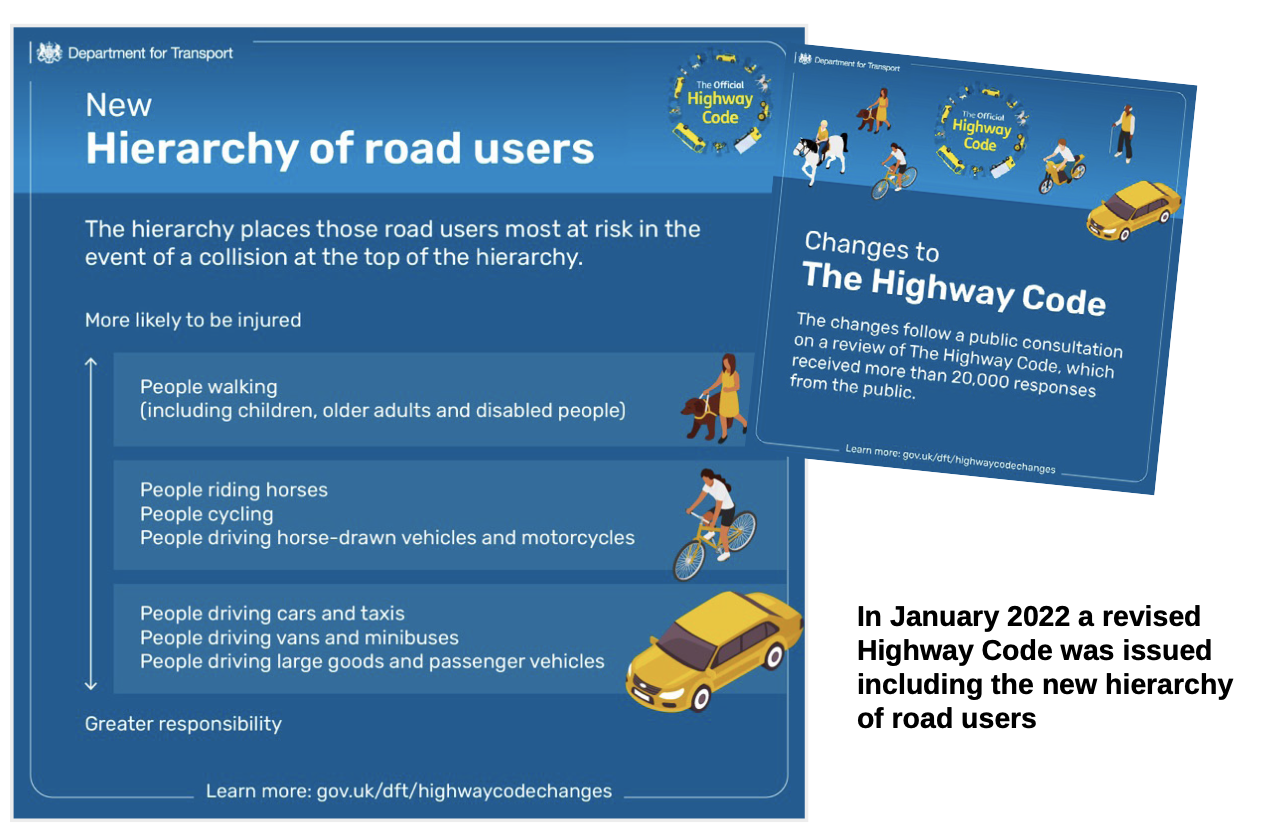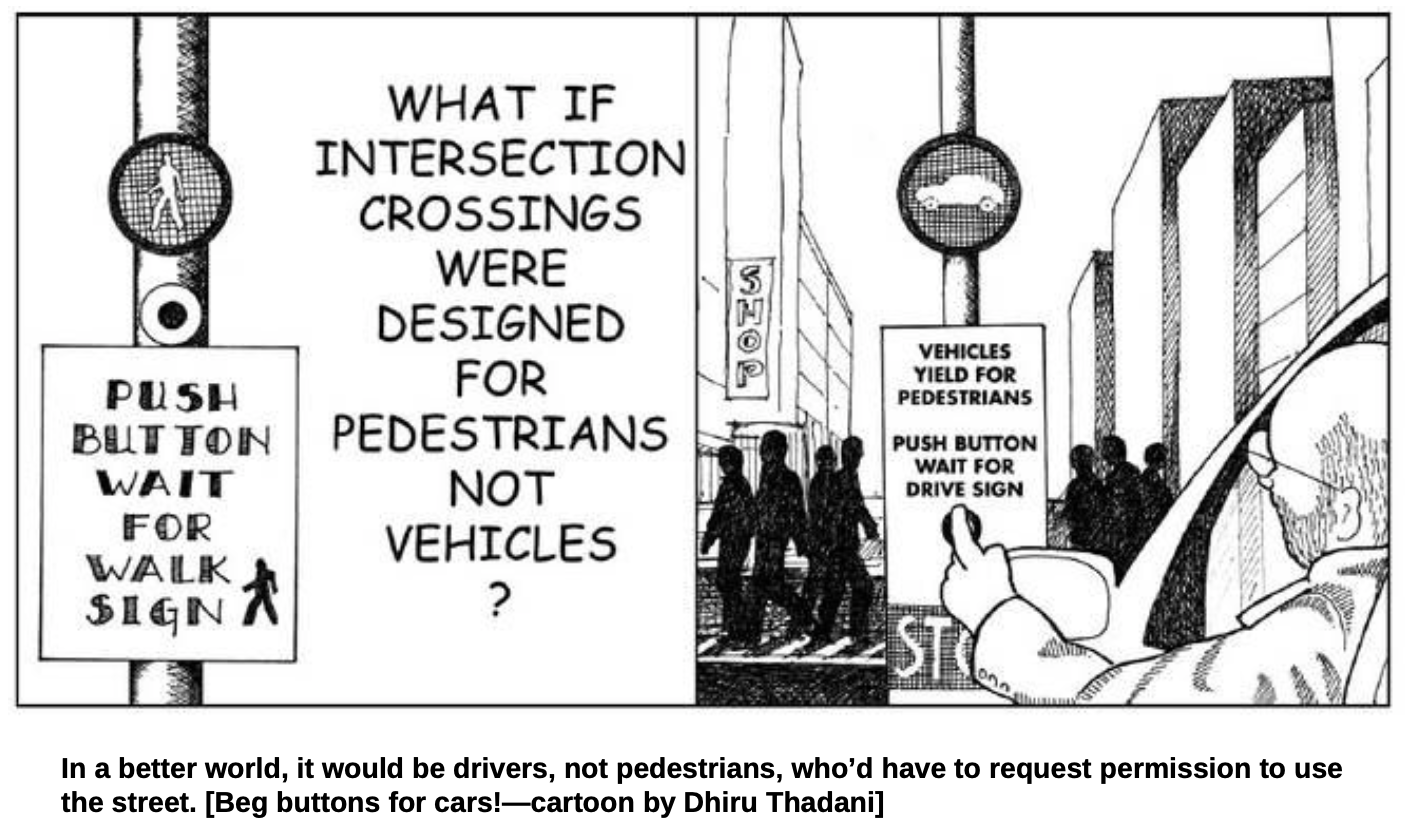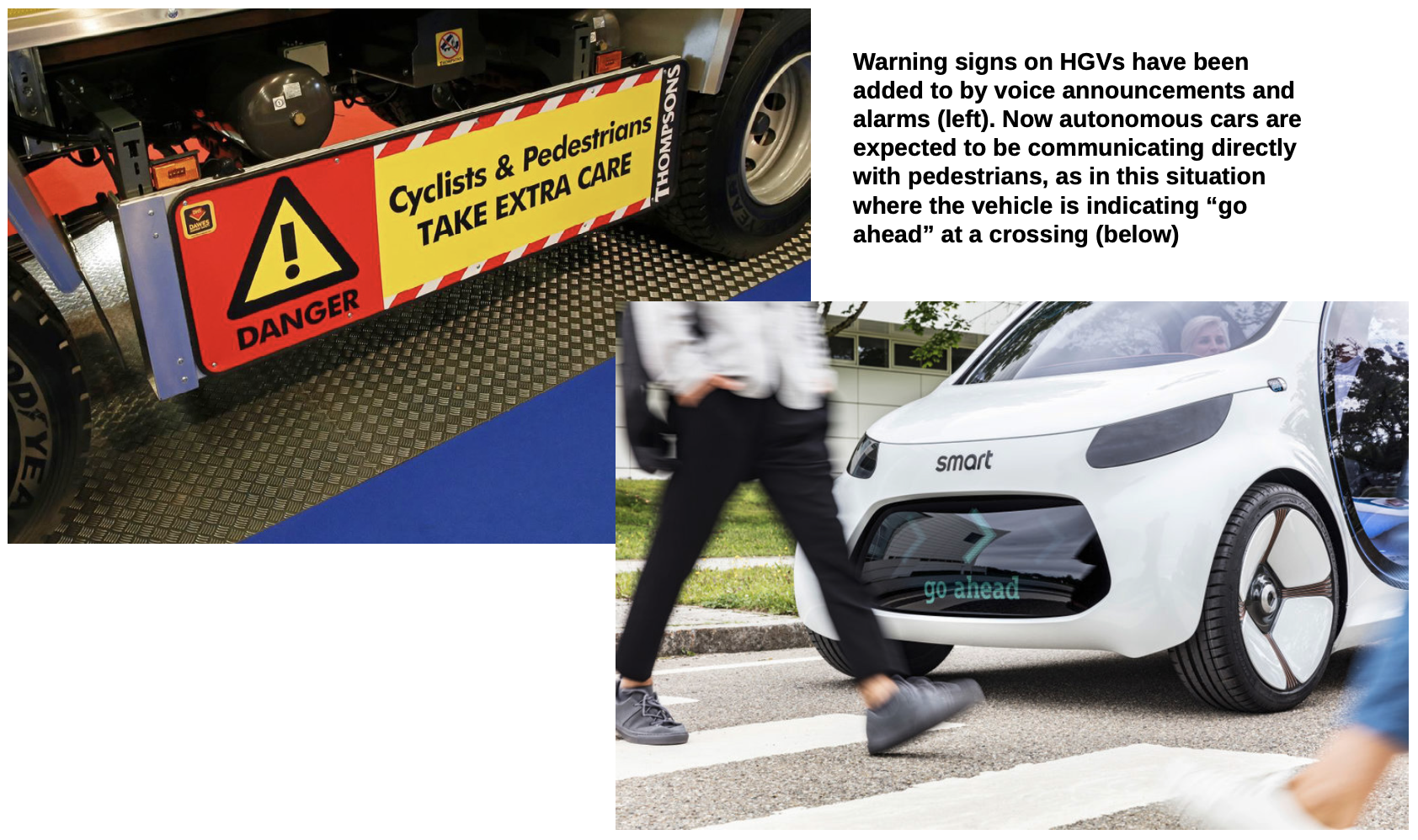TAPAS.network | 23 January 2024 | Commentary | Tom Cohen
‘Get out of my way’ thinking is an unfair route to road safety

Despite attempts to achieve a better balance between the interests of pedestrians and cyclists, and motorised vehicles on the local road networks they both share, why are the most fragile road users invariably expected to get out of the way of the most robust ones, asks . He looks at the realities of the hierarchy of responsibility set out in the recently revised Highway Code, and fears embedded thinking about traffic and highway engineering in the pursuit of road safety may only become more vehicle-dominated with the coming of automated vehicles
MUCH OF THE WAY we mediate the interests of different types of road users in urban areas depends on an implicit hierarchy of responsibility between them. This has much changed over time, from the days of horse riders taking customary precedence over those on foot, the famous Red Flag Act (the Locomotive Act of 1865) which required traction engines to be preceded by a person walking 60 yards ahead, at no more than 4 mph, carrying a red flag (not actually repealed until 1896 – coincidentally the same year in which the first pedestrian was killed by a car in Britain), the increasing dominance of the motorised modes in the latter half of the last century, and some intended reversal of that in 2022’s major revision of the Highway Code.
Over the years countless road safety measures have meanwhile been implemented to protect both drivers, passengers, and other road users – from speed limits, vehicle construction regulations, traffic and highway engineering measures, drink drive laws, road signage, traffic lights, seatbelt laws... to name but a few.
The Highway Code changes of two years ago seemed like a step along a different path – one that reflected the profoundly asymmetric nature of road danger. These arguably are the key sentences: “Those in charge of vehicles that can cause the greatest harm in the event of a collision bear the greatest responsibility to take care and reduce the danger they pose to others. This principle applies most strongly to drivers of large goods and passenger vehicles, vans/minibuses, cars/taxis and motorcycles”.
As I have said in earlier contributions, the specification of this hierarchy was an encouraging development and, if and when it is reflected in the behaviour of road users, we shall have taken a major step forward. But it also throws into relief the less rosy road-safety situation that has long obtained on our highways: the very fact that the hierarchy needed to be articulated surely tells us that all really is not well. Moreover the codifying of the hierarchy does not in itself address the imbalance of intent and expectation amongst road users as manifested on a daily basis in a number of more insidious ways. I would therefore like to reflect in this piece on the vexed issues of ‘responsibility’ and ‘taking care’, and I invite you to consider the implications of the increasing prevalence of technology being used to issue automated demands for people to “stand clear” of manoeuvring vehicles, and then move on from this to the potential serious challenges of providing for self-driving vehicles, and the relative responsibilities of those vehicles and other road users in achieving a suitable co-existence between humans and AVs.
In writing this piece, I was reminded of John Adams. Some 30 years ago, Adams was exploring the idea of risk compensation as applied to transport, and in particular the worrisome idea that if you helped people feel more safe, they would actually act more riskily. He applied it to the impact of seatbelts on driver care and attentiveness to the use of their vehicles, and the danger they posed to other road users. I feel I am exploring some kind of similar ‘balance of advantage’ conception here.

First a little history. When I was a lad, we had reversing lights. If you happened to be looking at the rear of a vehicle, you might have spotted they were illuminated, and would therefore know the vehicle would probably be, or be about to be, moving backwards. And, for what must be decades, that was deemed sufficient. Then, about 25 years ago, the sounds started. Sometimes an automated message – “Caution! This vehicle is reversing.” Before Securicor’s fall from grace, its name often featured in the announcement. Or there would instead be a loud beeping. Most recently, we have “Stand clear! This vehicle is turning left.” (Or right.) Note that these noises always emanate from larger vehicles. The injunction to stand clear would seem a significant development in ‘asserted priority’ (with no actual legal status) relative to what came before.
One interpretation of these developments is that technology has simply advanced: we would have had them before, only vehicles weren’t clever enough. But I don’t think it’s as simple as that. And I would disagree with anyone who claimed this is a trivial matter. Rather, I increasingly find the commonest elements of the transport system – so common that we don’t notice them – are often surprisingly important signifiers. The classic example is the pelican crossing: the walker/wheeler has become inured to seeking permission to interrupt the flow of vehicular traffic; the idea that drivers should instead press a button to obtain a green signal is so outlandish that it has been the subject of various cartoons.
But, returning to those hectoring vans, lorries and buses, and why I believe the emergence of “stand clear” instructions is significant. I see three things in play.
First, the implication is that the vehicle’s driver has a right to tell the walker/wheeler what to do, that there is a pecking order amongst road users. A teacher can tell a pupil to stand clear, but not vice versa. I have encountered the view that drivers of heavier vehicles view themselves as professionals, making the rest of us amateurs, and that this effectively entitles them to lay down the law. But I think it’s actually more of a case that “might is right.”
Second, the vehicle’s manoeuvre takes immediate assumed priority over any plans the walker/wheeler may have themselves had. It seems to apply the principle that “what I am doing is very important, and what you are doing is not”. Indeed, there’s no hint of negotiation or compromise here as to who should take precedence: instead, the simple message is “just get out of the (my) way”. You could in fact argue that this flows naturally from the first point.
Third, there is an explicit transfer of responsibility: it is not the driver’s duty to take care to avoid harming the undangerous road user; it is instead the latter’s responsibility to take evasive action.(Note here my deliberate use of “undangerous” rather than “vulnerable” – words matter.) Tied up with this is the, to me, inexplicable notion that it should be acceptable for a vehicle with the capacity to maim and kill to travel anywhere without the driver’s complete knowledge of what lies in its path.The two are of course connected: the undangerous road user is being told to stand clear precisely because the driver of the vehicle bringing danger has a restricted view. Making it unsafe for the latter to proceed, some might say.
I find all three of these phenomena disquieting, but the transfer of responsibility is possibly the biggest concern. And I doubt it has been tested in law yet, but I worry that, in the event of an injury, the defendant might claim that the victim had been warned to “stand clear” and therefore at least shares the blame. This is a bit like those ‘this water is hot’ notices on taps that seek to absolve the owners of premises of any consequential responsibility.

This is also partly explained by the cultural tendency of ‘promoting road safety’ being allowed to trump all other transport considerations, and to be simply interpreted as the proponent wishes it to be. Never mind whether being told to stand clear is unreasonable and/or unjust; because there is the possibility, perhaps only slight, that someone might get hurt, it is obviously the right thing to do. The causal chain between user behaviour and road trauma is so much more direct and visible than links between user behaviour, reluctance to walk/wheel/cycle and, ultimately, increased morbidity. So road safety wins the argument every time. And automated announcements from heavy vehicles are much cheaper to deliver and much less disruptive to the status quo than tackling the fundamental safety problem properly, as the very limited roll-out of the Direct Vision Standard (DVS) shows. (The DVS requires drivers of heavier vehicles to have a much fuller view of their surroundings than a typical cab provides. It has so far been implemented only in London.) This is surely the same thinking that led to ‘segregation’ of undangerous road users, and lining the roadside with guard railing. “Stay indoors, dear; it’s simply not safe out there with all these metal boxes moving about,” is really the core message.
All this would be easier to accept as the unwelcome way things just are were it not for those revisions to the Highway Code, which planted a seed of hope in me. Perhaps, I thought, we really are going to move on from the law of the jungle and enjoy, in its place, a more equitable way of sharing the road. But the hierarchy of road-user responsibility remains, I contend, just warm words. Worse, those words are painfully incongruous given road-user behaviour hasn’t, in my experience, changed even slightly since the hierarchy appeared. I sometimes in fact regret that I know about the changes; in this case, ignorance might be bliss. These automated instructions, about which I’m so exercised, are unarguably in direct opposition to the expressed new hierarchy. Instead of drivers of more dangerous vehicles taking more care, they are giving themselves permission to take less, and undangerous road users are being expected to take up the slack, having been duly warned. Another example of the casual embedding of injustice in our transport system. The “casual” part is important, because policy documents these days always make the right noises about prioritising the needs of those walking, wheeling and cycling. An explicit admission that it is acceptable (and expedient) to instruct undangerous road users to make allowances for drivers of dangerous vehicles would be unconscionable, so we instead watch that very expectation seeping quietly into the status quo without demur; amounting to a further tacit backward step.
All rather gloomy, I concede. Though perhaps not particularly remarkable, for we had similar debates about “cyclists – stay back” and the once ubiquitous stickers on heavy vehicles proclaiming “if you can’t see my mirrors, I can’t see you!” Much has in fact been said more generally about victim blaming in transport, and here it is again.
But, if there’s a useful lesson here, it is that we should all look more closely at aspects of the assumed order of things relating to the transport system that we take for granted simply because they are so common and/or because they arrive unannounced. They might not be as innocent as they seem. This could prove important in relation to the designation, configuration and legal status of automated vehicles and their use of the road network. We need to take care to avoid sleepwalking into a world in which AVs reinforce or, even, worsen these problems with both the hierarchy, and relative responsibility. We’re certainly sleepwalking at the moment, given the grandiose statements about the safety benefits of AVs that continue blithely to be made – for example just look at the background briefing notes for the AV Bill published alongside its appearance in the King’s speech last autumn.

For example, it stated “With 88 per cent of accidents currently involving human error, the potential for automated vehicles to reduce costs, injuries, and fatalities is enormous”; “Institute for Engineering and Technology research suggests that for every 10,000 errors made by drivers, a self-driving vehicle will make just one”.
In passing, I found this passage from the background to the King’s speech quite delicious: “safety gains from self-driving vehicles will not be a linear process, and there may well be incidents involving self-driving vehicles in the future.” Not accidents, note, but incidents. Words matter.
Artificial intelligence, we are told, will be a much better driver than we flawed humans. The fact is that it will be a very long time before we know whether that is actually the case. Meanwhile, plenty of peculiar and unpleasant “incidents” involving AVs are bound to have taken place, and judgement passed on who was at fault. Furthermore, during that time, we can be sure that the world, including people, will have remoulded to accommodate this technology, including its shortcomings, to ‘get the best’ from its application (and the growth of the associated AV production industry) as we humans just scurry for cover.
For example, I see potential parallels between the unsighted driver of a heavy goods vehicle and the non-existent driver of an AV. With the former, we fellow road users are being expected to accept a degree of responsibility because the driver does not know what’s happening around them. There are meanwhile some well-rehearsed arguments about what we can really expect of AVs when we look beyond the superficial assertions about reduced collisions (in selected conditions).
Here, it seems that the aforementioned John Adams was rather prescient. Back in 2017 he was one of two speakers invited to lead the discussion at a National Infrastructure Commission roundtable on connected and autonomous vehicles. The first speaker discussed the readiness of the road network for connected and autonomous vehicle. Adams’ presentation was subtitled Some behavioural challenges to think about. This is a very interesting is part of what he said: “One can find innumerable demonstrations by the promoters of driverless cars of their ability to programme their cars to respond with extreme deference to any pedestrians or cyclists who might wander into their path – and numerous acknowledgements of the necessity of this programming if driverless cars are to be permitted on public highways. Their cars, they boast, will respond with extreme deference to all vulnerable road users. One can find numerous illustrations of the ability of real sacred cows to cause traffic paralysis in Indian cities. Why would sacred humans, aware that the algorithms of the driverless cars that they encounter have been programmed to defer to them, not take advantage of their sacred status in ways that would lead to deferential paralysis in cities with lots of pedestrians and cyclists, and perhaps newly liberated free-range children?” Many may have missed the subtlety of Adams’ point: he was surely not suggesting that “Western” countries would allow the Indian situation to arise on their roads. In other words, treat promoters’ promises with appropriate scepticism.
But, giving AVs the benefit of the doubt for now, an optimistic view of what might happen is that the (2022) Highway Code will be written into the algorithms governing AVs and they will therefore observe it to the letter. Pedestrians waiting at a side road will be delighted to see at least the self-driving vehicles halting to allow them to cross. Well, one can dream.
More likely, I suggest, in the absence of the negotiation between human road users that takes place at the moment, convention will instead have to dominate to achieve ‘the wider benefits’. AVs won’t be able, for example, to make eye contact with human road users, so all action will be determined by the pre-existing set of rules. This helps to explain the extensive discussion about AVs being clearly labelled. Why so? So that we may adjust our expectations and behave accordingly. More disquieting even, is the idea that pedestrians and cyclists should wear beacons in order that they are readily recognised by AVs. One can imagine a subsequent court case surrounding the person who forgot or, perhaps, refused to wear their beacon and was run over. It was regrettably a tragic situation of their own making, your Honour.
Both of these propositions point to a less hopeful (and less just) arrangement once AVs are at large. By “adjusting expectations”, I naturally mean lowering them. And here we can circle back to our imperious heavy vehicles: I predict we shall have lower expectations of AVs than of human drivers, and undangerous road users, in particular, will be more tentative than they are with human-driven vehicles. A different cause – we’re being instructed by the heavies on the one hand and will be following our instincts with AVs on the other – but a similar outcome. So, undangerous road users will actually be taking more care than the hierarchy demands of them. The AV will, by definition, take no care at all, because computers don’t “care” in the sense of having compassion. That pedantry aside, I think they’ll prioritise their users and will respond to our nervousness by going more quickly and stopping less readily, as a new kind of ‘keep off the tracks” thinking takes hold. The consequence is that real conditions will depart yet further from the world envisaged by the hierarchy of road-user responsibility.
It does not need to be so. In the same way that we can challenge unjust developments such as lecturing vehicles when we see them on our highways, we can guard against new technology making things worse. But it does require us to re-assert some human, as opposed to technological, priorities. And to stop thinking it is our duty to ‘get out of the way’ of the machines that we have ourselves created.
References and Links
-
The Highway Code: 8 changes you need to know from 29 January 2022
-
To access the work of John Adams see his website Risk in a Hypermobile World http://www. john-adams.co.uk including 1985 Risk and Freedom: The Record of Road Safety Regulation; http://john-adams.co.uk/wp-content/uploads/2010/12/Management-of-the-risks-of-transport2. pdf; and The Pathway to Driverless Cars and the Sacred Cow Problem
Tom Cohen is a senior lecturer at the University of Westminster’s Active Travel Academy.
This article was first published in LTT magazine, LTT884, 23 January 2024.
You are currently viewing this page as TAPAS Taster user.
To read and make comments on this article you need to register for free as TAPAS Select user and log in.

Log in